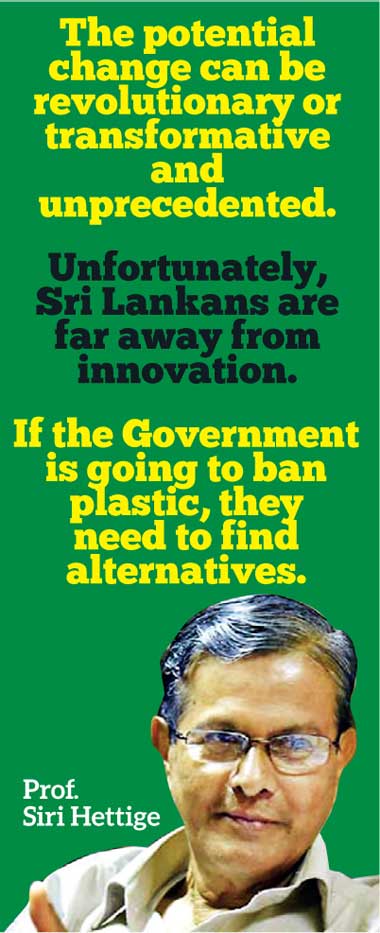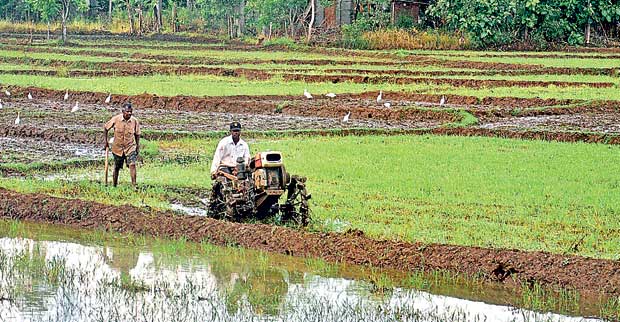
Sri Lanka, it’s high time for a Green Revolution
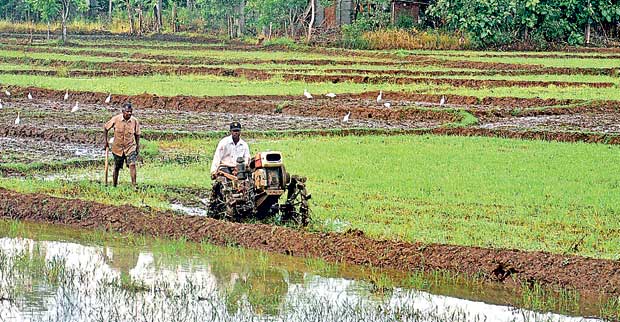
Sri Lanka, once identified at a time known granary of the East, is now almost reliant on imported food items. The unfolding problematic situation arose due to the considerable decline in domestic food production. As the global food crisis deepens due to various reasons, including armed conflicts, macro-economic collapses and natural disasters like droughts, many countries have started focusing on domestic food production. Sri Lanka’s agriculture-still being considered the most important yet- is a less encouraged sector that needs to undergo a transformation. Senior Social Scientist and Former Head of Sociology Department of the Colombo University Prof. Siri Hettige described this transformation as a ‘Green Revolution’. During an interview with the Daily Mirror, Prof. Hettige outlined the importance of taking the necessary actions to improve the productivity of the domestic agriculture sector. He said that this should be backed by investment on research, new scientific methods of farming and appropriate policy changes with the ultimate goal being known as the granary of the East again. Further, he aired his views on the significance of replacing non-bio degradable materials with bio-degradable materials which he said will solve the long-standing waste management issue and create a healthy environment.
How serious issues were dealt with
In the 1960s, the green revolution was a major policy response of many developing countries like Mexico, India, Pakistan, the Philippines and Sri Lanka. This was their response to a number of serious issues in traditional agriculture including low productivity, vulnerability of farmers, poverty and malnutrition. Consequently, agricultural scientists and others were exploring various ways to improve the small scale agriculture sector and the quality of lives of rural farmers. The change was made by introducing a range of new agricultural technologies.
Following decolonization, the population increased in many ex-colonial countries where there was stagnation of traditional agriculture. These countries faced a need to improve the conditions in rural areas since people were moving away from these areas, making the cities unmanageable. The Governments of such developing countries advocated certain interventions which were quite different to techniques used in large-scale industrial agriculture in countries like the United States. The new package that was introduced by the Governments included new seed varieties, new agricultural techniques like planting and mechanical type technologies. All these new methods gradually improved productivity of the lands. Consequently, the people had a much bigger yield whilst poor living conditions of farmers and issues caused by scarcity were addressed. The green revolution was backed by research conducted by newly established research stations.
Adopting a new green revolution in Sri Lanka
Sri Lanka and other countries need a new type of green revolution in response to a much bigger challenge we face at present; unsustainable development and unsustainable consumption. Development is taking place almost everywhere, but not in a sustainable manner. Correspondingly, there is unsustainable consumption. Both have resulted in major issues that are prevailing in the world such as climate change and the increasing disaster situations.
Slow onset disasters like floods and droughts appear to be sudden events. Nevertheless, they are part of a long- term trend. Accumulation of toxic waste is another problem. Some industrial products contain harmful substances. Such toxic materials end up in our food chain, water ways and even in the ocean. Some of the materials, that we have got used to, pose huge challenges in terms of disposal, pollution of the water ways, soil structure and the environment.
The main reason for this situation is the expansion of the industrial civilization, beyond the boundaries of traditional industrialized countries. The expansion of the industrial civilization has affected production and consumption of goods and services at an unprecedented rate.
-
Scientists should come up with bio degradable materials which are as good as plastics.
-
We have an artificially created labour problem.
-
Well-to-do people should use surplus of their income to create employment.
-
In India, green revolution made a huge impact.
Improving rural agriculture
Owing to the fact that Sri Lanka has been moving away from rural agriculture, there are thousands of acres of abandoned lands in all parts of the country. These lands can be used to produce raw materials for new income-generating industries that can produce substitutes for things that we have to replace like plastic bags, containers and many household items. Farmers should be encouraged to produce biodegradable material and be given science and technological know-how to do so. Once rural industries are initiated and developed, a large portion of imported items can be produced within the country. This way job opportunities will also be created. In other words, a whole new value chain can be established involving a whole range of public and private institutions. A significant part of the local population can get involved in this endeavour.
It will also eventually help to minimize rural-urban migration. Sri Lanka can’t continue to add more people to the cities. Cities are already over-crowded; people have lost open space. They should live in a healthy environment with clean air and open space. Development shouldn’t be confined to one place, but be dispersed.
In the 1960’s, many developing countries focused on how to improve the rural agriculture sector. In fact, traditional agricultural methods were not very productive. The seeds used weren’t high yielding. The output of grain that was produced on a unit of land was very low. Later, fertilizers and agro-chemicals were introduced. In India, a green revolution made a huge impact thus improving the living conditions of millions of people. But it also led to population increase.
Artificially created labour surplus
Labour migration can also be addressed through the green revolution. In fact, some people will anyway migrate for personal reasons. At least people won’t migrate just to make a living if job opportunities are created within the country. If the country provides social protection, decent working circumstances and favourable living conditions, Sri Lankans will be better off here and wouldn’t have to find employment abroad.
In such a circumstance, the labour within the country can be made use of. Sri Lanka doesn’t have a labour surplus. It’s just that Sri Lanka has an artificially created labour problem which has existed since the time people weren’t deployed in a reasonable way. This problem is attributable to the mismanagement of public finances. This issue exists not because people are leaving the country, but due to decision makers in the country being short-sighted.
Growing inequality
The country at present has so much inequality as it doesn’t effectively re-distribute income. What do the rich people do with their money? Are they responsible? If they are socially responsible entrepreneurs, they should create more employment opportunities. They can do this using their surplus of income for the purpose of contributing to the development of the country. There is no reason to have inequality in a country where we have seen economic growth and decreasing unemployment. On the other hand, globalization can’t continue unchecked. It has to be balanced by some degree of localization. In other words, both production and consumption have to be localized as much as possible. When it comes to the whole problem of globalization, everyone in the society has a role to play.
Concerns over non-bio degradables
Industrial products weren’t used for household needs in the past. Hundred years ago, there were few industrial products in this country. However, we are worried about such products today. Cleaning utensils like brooms and many other things were all made of natural materials. To begin with, Sri Lanka has to identify the things that can be easily replaced.
Excluding paper and cardboard which might be harmless in the long run, plastic and other synthetic materials could pose huge threats unless they are recycled in an effective manner or replaced by products made of natural material. In fact, plastic is very convenient and durable. The challenge for Sri Lankans is to move away from some of these materials and replace them with bio-degradable materials.
The question is whether it’s possible for scientists to do their experiments and come up with bio degradable materials which are as good as plastic. But, what exists is a much bigger process starting with a national policy, institutional development and the facilitation of the development of an entirely new value chain; production and processing of raw materials, design and manufacture, distribution and marketing and use and safe disposal.
If the Government is going to ban plastic, they need to find alternatives. The Government can’t simply ban plastic and ignore the consequences. Options should be suggested when getting rid of something. However, everything can’t be replaced. We don’t have to eliminate some materials, but such products can be reduced, reused and recycled.
No one can have 100% percent control over the use of non-biodegradable materials. Instead of using plastic bottles, why can’t we use glass, ceramic or stainless steel bottles? Why can’t people use bags made of natural fibres, clothes or paper instead of polythene? People give priority only to convenience, not to what is healthy.
This is a challenge which should be taken up by everyone including the educational authorities. There are urgent things like curriculum development, training of teachers, skill development and the creation of opportunities to acquire new knowledge. Everybody should fulfill he/she responsibilities to overcome these issues. This is an area where public and private partnerships can make a huge difference.
Targeting market of millions
There are problems of affordability in Sri Lanka as many people struggle to meet their basic needs. If things made of bio-degradable materials are quite expensive, the solution is to make them affordable. This can be done through large scale production, because then the price of a unit will drop. As Sri Lanka is a country with twenty million people, theoretically, this nation can produce anything in millions, even for the domestic market.
If people get familiar with alternatives to plastic like clothe, reed and paper, there will be a continual demand for such products. This shift will ensure that production will rise, reducing the price of a unit. If production takes place in large volumes- targeting the entire population of the country- the demand will bring the price down. Even a Pettah market vendor knows this theory. Nonetheless, there is a need to strengthen a whole range of institutions which will facilitate production and encourage the use of bio-degradable materials so that there won’t be any scarcity.
Farmers need assistance
Farmers who are struggling to make a living can’t survive with their own devices. They need to be assisted by specialist institutions led by the leaders of innovation. There should be cooperatives and organizations that can assist farmers. Many rural women, who are left behind, will be able to play a major role in the new green economy for their own benefit as well as that of the country and the environment.
At present, children are pushed by the system only to graduate through regular schools and universities. Eventually, many of them don’t come up with useful ideas for their future. This is the result of responsible adults not getting the children to start thinking from the early childhood. If they do, they will have innovative minds to meet global challenges by the time they graduate from schools and universities. Computer assisted design is one area that can open up many opportunities for youth.
Unfortunately, Sri Lankans are far away from innovation. Instead, they are using whatever materials they have and contributing to the problem. However, many other countries have often played their roles. It’s high time that Sri Lankans stop sitting and relaxing. East Asian countries, as a result of their pragmatism and entrepreneurship, have always come up with new products because they have allocated substantial public finances for education, research and the science sectors.
People’s responsibility
The main point is that the country has to move towards a greener economy which demands people to produce and consume responsibly. The potential change can be revolutionary or transformative and unprecedented. To meet these challenges, we require a major shift in the way we think and live. We can’t consume things in the way we do right now. While getting rid of certain things, we have to start embracing certain new things, which aren’t widely used today.
A greener future will be healthier, sustainable, human friendly and more acceptable while also addressing prevailing social and economic imbalances. What we discussed today is a small part of the green revolution that is yet to happen here and elsewhere. Nevertheless, the new green revolution will be very creative, so it isn’t going back, but having a combination of what nature can offer together with scientific knowledge. This revolution will touch and enrich the lives of everyone in the country irrespective of differences among people.
The Government should take a policy decision in this regard in order to take the initiative and provide the necessary policy support. There should be consensus among all social groups to implement it. Other stakeholders should be in line to support the implementation of the policy. There is a role to be played by intellectuals who could bring people altogether and make them aware of the potential transformation. Scientists also have a major role to play in making the transformation possible. Basically, all should get together and take the necessary steps for a healthier and more sustainable future.
Source – DailyMirror, See more at – http://www.dailymirror.lk/article/Sri-Lanka-it-s-high-time-for-a-Green-Revolution-134696.html
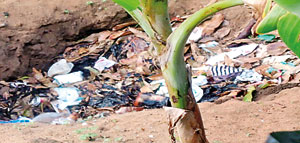
Letters to the Editor
Look beyond fumigation and burning garbage to tackle dengue menace
It was reported that from the beginning of July, thousands of soldiers, airmen and sailors have supported the Public Health Inspectors (PHIs) in a house-to-house campaign to identify mosquito breeding areas and take corrective measures.
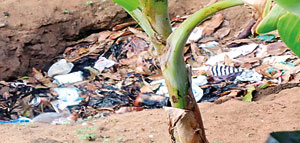 I live in Kochchikade (Negombo) and, alas, I have hardly seen attempts to identify mosquito breeding places in my area- no officials have visited my or neighbouring premises, although there were many people in the area affected by dengue. Somebody said households would be inspected on July 12 and if a mosquito breeding place was found, the owners of the premises would be liable to a fine of Rs. 50.000,000. No officials turned up but, everybody tried to clean their surroundings by lighting massive fires and burning all accumulated rubbish, plastic items included.
I live in Kochchikade (Negombo) and, alas, I have hardly seen attempts to identify mosquito breeding places in my area- no officials have visited my or neighbouring premises, although there were many people in the area affected by dengue. Somebody said households would be inspected on July 12 and if a mosquito breeding place was found, the owners of the premises would be liable to a fine of Rs. 50.000,000. No officials turned up but, everybody tried to clean their surroundings by lighting massive fires and burning all accumulated rubbish, plastic items included.
A couple of days later, there was a thundering sound and from a cloud of smoke, like in one of those Doomsday films (Apocalypse now), appeared a ghastly figure with a mask and a menacing looking fogging device. I was told to go inside my house and close the door. I obeyed but later on I wanted to find out whether that fogging had any effect on the mosquito population. Half an hour later, around six p.m., the first mosquitoes flew into the house and I managed to kill them with an electric mosquito swatter. Next morning, as I usually sleep with an open window under a mosquito net, I found and killed some 30 more of them.
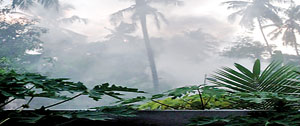 The Daily Mail of September, 2016
The Daily Mail of September, 2016
There is data which suggests that mosquitoes have become resistant to the chemicals used in fumigation and may not die. Furthermore, fogging kills other insects that feed on mosquitoes. Dengue has to be controlled at the larval stage. It is commendable that the Sri Lankan government decided to seek foreign help in fight against dengue and is ready to introduce a new method to rein in dengue.
Many Sri Lankans, believe that burning rubbish, including plastics, can deter mosquitoes. This is an illusion and therefore, the media, governmental bodies, schools and other public institutions should educate people about the menace of burning plastic items in their gardens. It is indisputably proven that burning plastics emits carcinogenic, toxic smoke and causes Chronic Obstructive Pulmonary Disease and sometimes cancer.
S. Mack
Via email
Engineers’ protest against new power plan lacks professionalism
In a letter to the Minister of Power and Renewable Energy Ranjith Siyambalapitiya on July 27, the Ceylon Electricity Board (CEB) Engineers’ Union (EU) has demanded the urgent intervention of the minister to get the CEB to facilitate the unhindered procurement of future power plants as per its Least Cost Long Term Generation Expansion Plan (LCLTGEP). Extracts of this letter were published in the media, in a press article, which reported that the Ceylon Electricity Board (CEB) Engineers’ Union (EU) allegedly levelled several allegations against the Public Utilities Commission of Sri Lanka (PUCSL) in respect of its decision to reject the CEB’s Long Term Generation Expansion (LTGE) Plan and recommending an alternative Plan comprising natural gas operated power plants in place of coal power plants as proposed by the CEB.
Among these allegations are:
1. PUCSL lacks people of proven calibre who will function objectively and in a professional manner.
2. PUCSL has no discretionary powers to amend the submitted plan on its own.
3. PUCSL’s action in approving the LCLTGEP 2018-2037 of the CEB is totally unsatisfactory.
The concerns raised by CEB in the said letter, that PUCSL is not staffed by “people of proven calibre who will function objectively and in a professional manner”, is a matter of dispute taking into consideration the fact that the recommendation made by the PUSCL, balances the health and safety of the very people whose energy demands are being met with the LCLTGEP 2018-2037. This decision boasts of the holistic approach by the PUCSL as opposed to the short sighted approach of this concentrated group of highly respected professionals making these allegations. Further to this, the CEBEU states that they “had no other option but to resort to trade union action to safeguard their membership and the sector from such individuals”.
One wonders why the CEBEU as a trade union feels their membership will get affected when decisions are being made to humanize the issue and for the betterment of the community as a whole?
It is accepted that professionals express an opinion supported by scientific facts and giving sound reasoning in rejecting and/or accepting the opinion of another. Therefore one would expect the CEBEU to also reveal as to why they reject this decision of the PUCSL, without resorting to levelling allegations against a parallel public institution in what reeks strongly of prejudice.
The press release claims that the PUCSL has not acted according to the provisions in the Electricity Acts. But the fact is that it is the CEB who has violated the provisions in the Electricity Act in preparing its LTGE Plan. The Amended Electricity Act No. 31 of 2013 says “For the purpose of this section- “Least Cost Long Term Generation Expansion Plan” means a plan prepared by the transmission licensee and amended and approved by the Commission on the basis of the submissions made by the licensees and published by the Commission, indicating the future electricity generating capacity requirements determined on the basis of least economic cost”.
The CEB’s LTGE Plan has been prepared based on the cost of production incorporating the amortized capital cost, operation and maintenance costs and fuel cost only. There is no economic component taken into account, obviously because being engineers, CEB staff may not have any knowledge of economics to prepare a Plan based on least “economic” cost. Hence, before protesting against the PUCSL Plan, the least the CEB EU could do at this stage is to consult an economist and find out how to include “economic” cost into their equation. Since the draft Plan submitted by CEB to the PUCSL does not conform to the country’s law as it is not based on least “economic” cost, it is not legal and no one can enforce it.
The bottom line is that when the economic component is added, the least cost option shifts from coal power to gas power. If the CEBEU opposes to gas power for future generation for whatever the reasons, they should come out with it giving valid reasons as professionals, without threatening to strike.
Source – 13/08/2017, The Sunday Times, see more at – http://www.sundaytimes.lk/170813/plus/letters-to-the-editor-2-254334.html
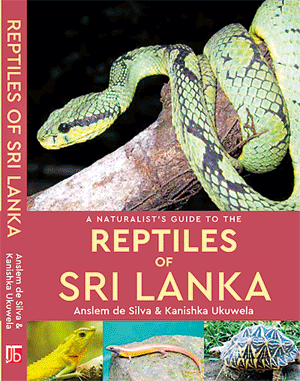
Handy guide to Sri Lanka’s reptiles
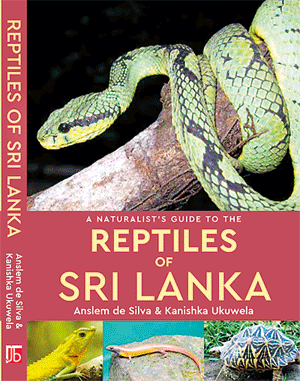 There is a long string of publications focusing on nature not only linked to Sri Lanka but also the region.
There is a long string of publications focusing on nature not only linked to Sri Lanka but also the region.The latest to ‘roll off the presses’ from John Beaufoy Publishing based in Oxford, England, are herpetological titles including ‘A Naturalist’s Guide to the Reptiles of Sri Lanka’ by Anslem de Silva and Kanishka Ukuwela. The guide will be launched next month at the International Book Fair.
This 176-page paperback is filled with colour images, 300 in all, and may be ordered from Vijitha Yapa Publications on www.vijithayapa.com.
It is described as an easy-to-use identification guide to the 150 species of reptiles including snakes, lizards and turtles, most commonly found in Sri Lanka, with their features, distribution, habitat and habits given in detail. An overview of the climate, vegetation, folklore and snake-bite management is also part of the guide.
A complete checklist of the reptiles in the country along with their status, both regionally and internationally, is available within its pages.
John Beaufoy Publishing is an independent book publisher which specializes in the fields of natural history, travel and adventure, with a focus on the tropical regions of Southeast Asia, Africa, Central America and the Caribbean: The parts of the world lying between the tropics of Cancer and Capricorn.
Source – 13/08/2017, The Sunday Times, See m,ore at – http://www.sundaytimes.lk/170813/plus/handy-guide-to-sri-lankas-reptiles-253976.html
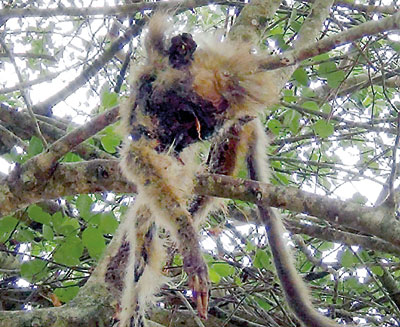
Punishing drought takes heavy toll across Puttalam district
The Puttalam district is experiencing its worst ever drought in the past four and a half decades – and the residents suffering from its devastating effects lament the Government’s assistance is woefully inadequate.
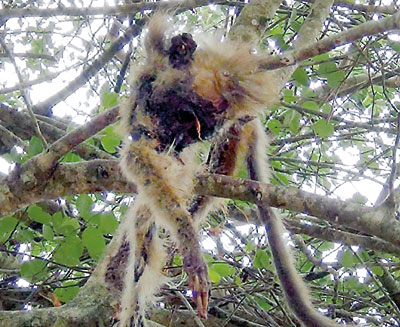
Thabbowa: Dead monkeys on tree tops
A Sunday Times investigation found that the drought has affected more than 164,000 people in 14 of the district’s 16 divisions. The Disaster Management Center’s (DMC) Puttalam office has deployed 17 water bowsers to distribute drinking water to the residents, whereas the situation demands at least double that number to meet the drinking water requirement of the residents. According to DMC’s own admission, at least another 19 bowsers are needed.
District Secretary N.M.N. Chitrananda said the most pressing problem faced by officials engaged in providing drinking water to the affected people was that even the few remaining water sources were fast drying up As such, he said he had instructed divisional secretaries to dig wells at the bottom of dried up water tanks. Permission has also been granted to construct tube wells, overruling objections raised by the Water Resources Board, he said.
The drought, now into its ninth month, has also dealt a severe blow to the economic life of the people who make a living out of cultivation. About 1,250 of the district’s 1,300 small irrigation tanks have now dried up. The water levels of the district’s two main reservoirs at Inginitimitiya and Thabbowa have decreased drastically. Paddy cultivation is at an all-time low while subsidiary crops such as betel, bananas and tea have also been virtually wiped out.
In Nawagattegama, more than100 betel fields have been affected. As a result, about 500 daily paid labourers have lost their jobs, Divisional Secretary R.P.G. Podineris said.
Those engaged in inland fishing said they would also be jobless soon if the drought continued.
Also hit by the punishing drought are dairy farmers. With grazing areas fast dwindling and water in short supply, farmers struggle to keep their cattle alive.
According to North Central Province’s Department of Animal Production and Health, some 50,000 cattle in the Puttalam district are at risk due to severe food and water shortages.
The prolonged drought has also severely disturbed the region’s eco-system. Forest areas are scattered with the carcasses of wild animals which died agonising deaths without water. Bodies of dead monkeys on trees are a common sight.
Source – The Sunday Times, See more at – http://www.sundaytimes.lk/170813/news/punishing-drought-takes-heavy-toll-across-puttalam-district-254390.html
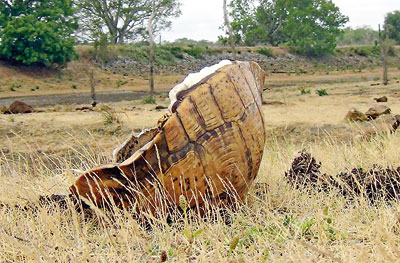
Welcome rain brings some relief, but not enough to end drought
While torrential rains this week brought much needed relief to several drought-hit regions, officials warned that the drought itself is set to continue at least until the beginning of October.

Nuwara Wewa, Anuradhapura
Anuradhapura, Polonnaruwa, Trincomalee and Mullaitivu districts all received heavy rainfall over three days this week, resulting in significant improvement in some areas affected by drought. The most striking example was in the Trincomalee district. The Disaster Management Center’s (DMC) statistics issued a week ago on August 5 noted that nearly 141, 000 persons from more than 37, 000 families in the district were affected by the drought. This number has fallen to 36, 000 people from 10, 700 families as of yesterday (August 12). “The rains have significantly improved the situation in the Trincomalee district,” DMC’s Assistant Director Pradeep Kodippili, the told the Sunday Times. Mr Kodippili however, warned that there were still no signs that the drought was abating.
The rains “aren’t enough” and besides Trincomalee, the situation in most other areas remained the same, the official stressed.
The main problem continues to be a severe shortage of drinking water. Mr Kodippili explained the DMC has been distributing drinking water to drought-affected areas for the past eight months using about 500 bowsers, 200 of which were sent into service within the past two months as the drought became more intense. About 6000 water tanks have also been delivered to affected areas.
More than 1.24 million people from over 360, 000 families in 19 districts were affected by the drought as of yesterday, according to the DMC. Kurunegala district remained the worst with 200, 000 being affected, up from 151, 000 a week ago. This meant almost 60, 000 families. Puttalam district with over 164, 000 affected people was next. Jaffna District saw 128, 652 persons affected while the number in Mulliativu stood at 115, 308. Between 85, 000 to 90, 000 persons were affected in each of the districts of Anuradhapura, Vavuniya, Kilinochchi and Mannar.
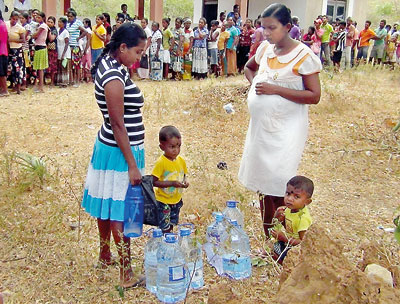
Mahakumbukkadawala: Waiting for potable water
Meteorology Department Director K.H.M.S Premalal observed that water was still scarce in most drought-hit areas despite the rains this week. “We have to remember that many tanks in the affected areas have either run dry or their water levels have dropped considerably,” he pointed out. There has to be a prolonged period of heavy rain for the effects of the drought to diminish, and such rains are only expected towards the end of September when the inter-monsoonal rains become active, he added.
Inter-monsoonal rains generally account for 30 per cent of the country’s total rainfall and their effectiveness will be vital in ending the drought period, Mr Premalal noted.
The Irrigation Department has 73 major tanks coming under its purview. The total balance water availability of these tanks has now fallen to just 14 per cent, Wasantha Bandara Palugaswewa, Director of Irrigation (Water Management & Training) disclosed. “Many smaller tanks have run completely dry.”
Nevertheless, the Department had been able to release water adequate to cultivate about 50 per cent of paddy lands due to be cultivated during the ‘Yala’ season, Mr Palugaswewa claimed. “Despite the difficulties, we were able to release water for cultivation purposes and we are now at the tail end of the Yala season.” Water was still being released from certain large tanks in the Anuradhapura and Polonnaruwa districts.
Mr. Palugaswewa added that heavy rains which were experienced in Anuradhapura and Polonnaruwa this week was an encouraging sign and said officials were hoping for more of the same.
The drought has also impacted hydropower generation. However, some heavy rains were also experienced this week in areas where hydropower reservoirs are located. Maussakale, Castlereigh, Kotmale, Norton Bridge, Canyon, Lakshapana and Kukuleganga hydropower reservoirs received rains this week. This has resulted in total water levels of hydropower reservoirs reaching 39.6 per cent by yesterday, up from about 36.4 per cent two weeks ago, Director (Development) of the Ministry of Power and Renewable Energy and Ceylon Electricity Board (CEB) Spokesman Sulakshana Jayawardena stated. This however, is only a minor increase, he insisted.
At present, just 20 per cent of the country’s daily electricity demand is being met by hydropower. The balance 80 per cent is being generated mainly by diesel and coal power.
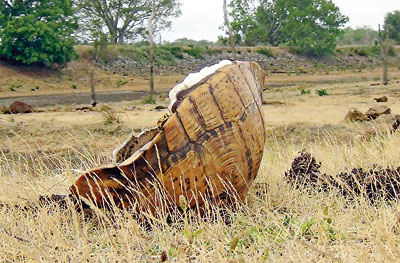
Thabbowa: Dead tortoise

Meegaswewa: Providing drinking water for hard-hit wild animals
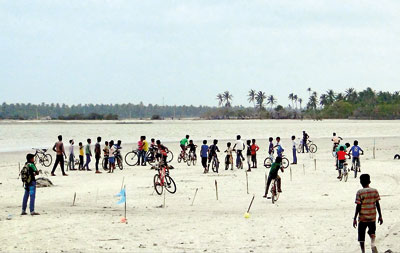
Dried up tank in Kalpitiya. Pix by Athula Bandara, Hiran Priyankara Jayasinghe and Karuwalagaswewa Jayaratna
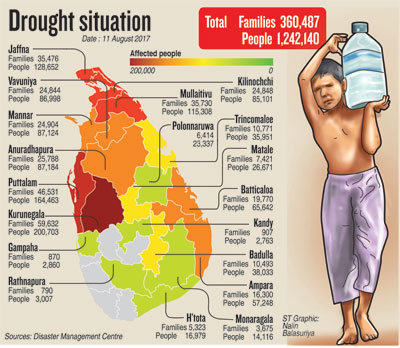
Source – 13/08/2017, The Sunday Times, See more at http://www.sundaytimes.lk/170813/news/welcome-rain-brings-some-relief-but-not-enough-to-end-drought-254393.html
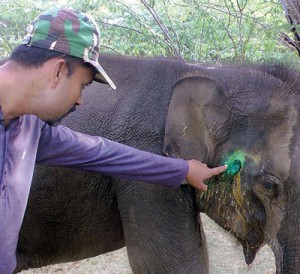
Explosives killing hundreds of elephants, protection handicapped
A four-year-old elephant, which had suffered severe injuries after biting an explosives-packed device used to hunt wild animals for human consumption is fighting for its life.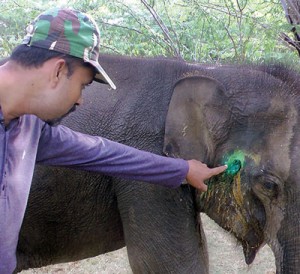
The illegal device commonly known as —‘hakka pattas’ — a mixture of explosives with lead and ball bearings inserted into a piece of pumpkin had been placed in a location in Hambantota. It is at that site where the wounded animal had been found nearly two weeks after the incident.
The explosion had mutilated its jaw bones, teeth, and ripped off a foot long piece of trunk. The animal is being treated at the Elephant Transit Home Udawalawe.
Veterinary surgeon, Dr Malaka Abeywardena told the Sunday Times that even after three days of treatment, there had not been any improvement as of Friday.
“Due to the damage to the jaw and teeth of the elephant calf it has to take liquid food. It is malnourished and weak making anaesthetised surgery impossible.’’
Dr Abeywardena said that that the calf would have roamed near Hambantota harbour for over a week after being wounded. The animal’s mouth and the side of it’s head was infested with maggots.
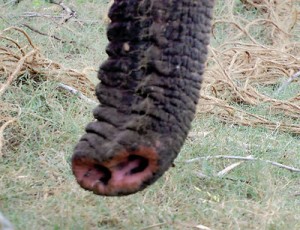
“Antibiotics are given twice a day, while saline, energy boosting medicine and vitamins are given regularly,’’ he said.
Incidents of elephants being killed by using hakka patas, shooting them or poisoning them are on the rise.
Within the last five years, from 2012 to 2016 around 1,171 elephants have died out of which only 104 had died due to natural causes, according to the Wildlife Department.
The survey on the elephant population done in 2011 revealed that the number of elephants in the country around 5,800.
Statistics show that during last year alone 279 elephants were found dead and only 35 of them had died due to natural causes.
Dr Tharaka Prasad, director of wildlife health at the Wildlife Department as well as the chief veterinary surgeon, said more deaths take place because of gun shot wounds.
He said that a tusker and another elephant suffering from gunshot injuries are struggling for their lives in Kala Wewa, Anuradhapura and in Minneriya respectively.
“Elephants which are shot can only be identified when the animal shows signs of weakness or seen limping towards a pool of water. Its too late then as it is badly infected by that time,’’ he said.
Dr Prasad noted instances of elephants wounded by trap guns set up by farmers and surviving for years after the wounds heal, but the corrosion of the iron balls embedded in their flesh, kills them eventually.
He explained that some farmers kill elephants by using toxic pesticide in vegetables. Electric fences can also kill elephants in minutes or within days.
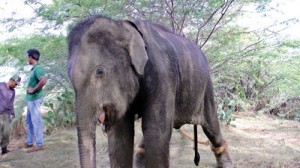
The explosion had mutilated the baby elephant’s jaw bones, teeth, and ripped off a foot long piece of trunk. Pix by Rahul Samantha Hettiararchchi
“At least three elephants are found dead every week. If an animal that has been poisoned, eaten hakka patas, or has suffered burn injuries from an electrical source, is found alive, there is little chance to save it,’’ he explained.
There are 15 wildlife veterinary surgeons, but their main task is to handle any epidemic situation in wildlife parks and not individual cases.
Meanwhile, wildlife rangers, guards and officials from various parks spelt out the difficulties that they face in elephant conservation. There is not enough staff for monitoring, for raids, to investigate those who set explosives, or those who leave poisoned food in the paddy fields bordering forests.
There is also not water in Galagmuwa, Giribawa, Hambantota, and Meegalawa because of the drought. Water is brought in by tanker trucks only into some areas.
“The elephants which roam in search of water take down electric fencing and enter villages.The villagers shot them,’’one of them said.
The lack of staff means they have to call up the unarmed Civil Defence Force to help. They are not trained to handle wildlife issues.
The rangers also claimed that some elephants are wounded by their own officers because they use live ammunition, not rubber bullets.
Director general of the DWC, M G C Sooriyabandara, said that over 65% of elephant deaths are caused by shooting.
Elephants who fall victim to hakka pattas could suffer for over three months and starve to death.
Mr Sooriyabandara said that use of hakka pattas within or outside of wildlife reserves is illegal, but detection is difficult.
“According to the Fauna and Flora Protection Ordinance any person who kills or harms any protected animal is liable to a jail term and or a fine of Rs 200,000 to Rs 500,000.
Mr Sooriyabandara admitted that the DWC is short staffed, but said offenders can be arrested.
He denied that live ammunition is used and explained that rubber bullets are provided to officers for emergencies.
“We never encourage officers to shoot animals. We never provide live ammunition, but if individuals are using them we will investigate.’’
Minister of Sustainable Development and Wildlife, Gamini Jayawickrama Perera, said he wants to find the companies making firecrackers that provide people with gunpowder to produce hakka pattas.
If animals continued to suffer, new laws will have to be drafted to restrict gunpowder issued to villagers, he said.
Mr Perera said that the department needs at least 1,000 officials. He had informed the cabinet that 200 people are urgently needed.
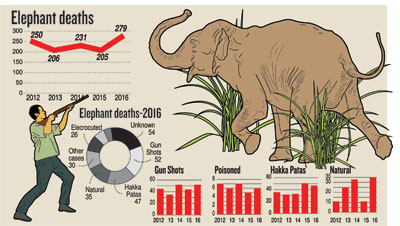
Source – 13/08/2017, The Suinday Times, See more at – http://www.sundaytimes.lk/170813/news/explosives-killing-hundreds-of-elephants-protection-handicapped-254356.html
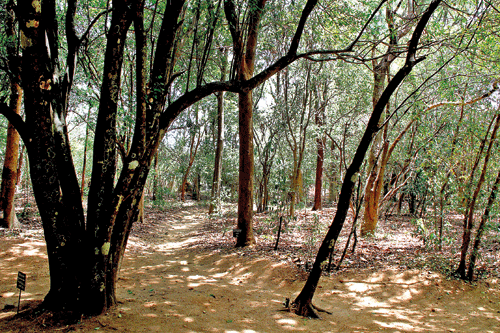
Celebrating the uniqueness of Popham’s Arboretum
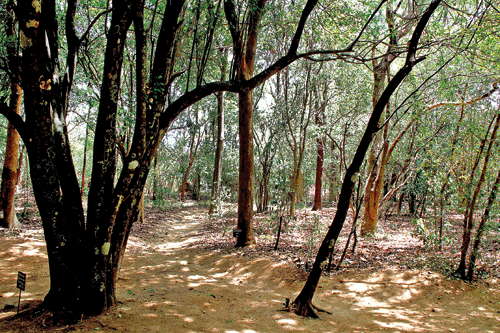
Growing wild: Popham’s vision realised. Pix by Indika Handuwala
I have been on so many overseas expeditions but this visit to Sri Lanka is undoubtedly the best so far both in terms of biodiversity and hospitality. Such diversity within one canvas is just incredible,” says Josh Raper, a Falmouth University Marine and Natural History Photography graduate. Josh is among the group of visiting Falmouth students on an expedition tour in the National Institute of Fundamental Studies (NIFS) – Popham Arboretum in Dambulla.
The research team of Conservation Photography students led by Dr. Margaret Upton, Senior Lecturer from the Falmouth University, UK, was here on a one-month tour in July. The first international visit of this scale to the Popham Arboretum, set up by the British planter and former naval officer, Francis Home Popham way back in 1963, it aims to promote international research at this only naturally regenerated arboretum in the country.
The arboretum which Sam Popham gifted to the then Institute of Fundamental Studies (IFS), in 1989 is presently managed on behalf of NIFS now (National Institute of Fundamental Studies), by Ruk Rakaganno.
The tour was facilitated by Prof. Mayuri Jayasinghe from the Faculty of Zoology and Environment Sciences, University of Colombo on a link made possible by Simon Lazenbatt, a member of Ruk Rakaganno. Simon, a one-time ‘pharmaceutical guy’ whose professional commitments first brought him here in 1984, was bowled over by the natural beauty of the island. “I kept coming for vacations with my wife who too fell in love with the place, so much so we both wanted to live here after my retirement and here we are having realized our dream,” says Simon who has made his abode in Naula.

Sam Popham
Simon who came to associate with the Arboretum through his involvement with Ruk Rakaganno initially linked up the Zoology Faculty of University of Exeter. “The zoological tour which did not materialize last year, finally evolved into an educational tour of photography this year with Falmouth University tying up,” explains Simon who sees it as a stepping stone to more progressive ventures in time to come. A database of photographic material is being generated and will be donated by the Falmouth group. This valuable resource material, with proper management and the will and vision to utilise it properly, can be used to produce promotional materials and items for sale to visitors, says Simon. “Currently there are no informative or souvenir items available for sale, which means a huge opportunity to support the Arboretum has been lost up to now,” he notes.
NIFS-Popham Arboretum which is home to around 200 species of flora, among them, several endemics, is also a place to see the Slender Loris. The arboretum in the dry zone proudly proclaims its genetic diversity. “We couldn’t have expected a better place which would do justice to our theme of ‘Science meets Photography,” reflects Josh Pawlowski, second year student of Marine and Natural History Photography at the Falmouth University who is excited about developing a series of documentaries together with his fellow students.
These documentaries will bring under the spotlight the evolution and the importance of the Popham Arboretum and its flora and fauna with special emphasis on the Loris. Their specialist gear, including heat sensitive and night vision appliances, enable non-obtrusive observation of the wild life and more sophisticated documentation of the behaviour and ecology of the Loris population in particular. An exhibition celebrating the arboretum and its biodiversity, is also in the pipeline says Josh for whom the first time ‘tropical experience’ has been just overwhelming. Such exposure, as the young photographer asserts, it is hoped, will kindle interest in the Arboretum in UK-based wildlife media and other like-minded individuals.
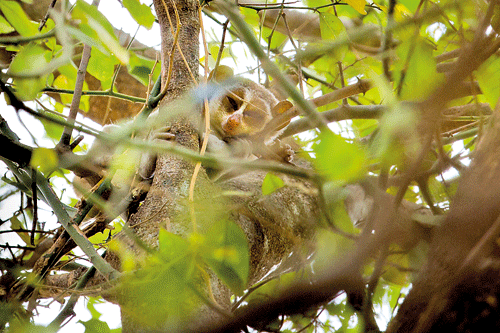
Additional attraction: The slender Loris. Pic by Lewis Easdown
For Josh Raper, the visit had been a thrilling photographic experience, along with a food encounter with Sri Lankan pumpkin and spinach! For Meike Simms, a Zoology graduate, currently working in wildlife tourism, the Popham Arboretum also offered insights into other issues such as what levels of tourism should be best for Sri Lanka in terms of sustainability without disturbing the natural equilibrium, especially in wildlife parks, she notes. Our potential for wildlife tourism is enormous, says Meike who also asserts that collaborations of this nature become a bonus in the process.
The mud hut which is at times an auditorium transforms into a lunch room where all youngsters help themselves to a simple Sri Lankan lunch where papadam seemed to hold sway and monkeys keep them amused! Held in nature’s rapture, they look forward to the next visit to the island, with the Kandy Perahera and tea estates on their bucket list.Lauding the NIFS-Ruk Rakaganno collaboration which made the visit possible, Dr. Margaret Upton looks forward to similar student-centric encounters in the near future. “With the intervention of Prof. Mayuri Jayasinghe, hopefully we can enter into a MoU with the University of Colombo, so that a mutual learning experience will be possible and exercises of this nature could be sustained.”
The conservation of the Arboretum fuelled by schemes of this nature becomes increasingly decisive, given the exclusivity of the place, says Prof. Jayasinghe. “Compared to the wet zone, endemism in the Dry Zone is poor further intensified by the post-war phase where forests have been cleared at an alarming rate. In this backdrop, the Arboretum emerges an exception with its rich biodiversity converged into an inclusive landscape of around 36 acres,” she observes.

Margaret Upton
Several interactive sessions were held with leading researchers and scholars including Prof. Wipula Yapa, Head, Department of Zoology and Environment Sciences, University of Colombo and Prof. Siril Wijesundara, Research Professor from NIFS.
The visit of the students had been at a ‘critical juncture’, says Prof. Siril Wijesundara who serves on the management committee of the Arboretum. He urges for sustainable scientific collaborations both local and international which would reflect positively on research as well as the Arboretum which requires upgrading. “Although we have had on-site research programmes before, this is the first time a venture of this scale is taking place and through the proposed tripartite MoU, we hope to promote theme-based research,” he says.
With the more consolidated partnership between NIFS and Ruk Rakaganno coming into place, the conservation efforts of the Arboretum certainly appear to be more encouraging, asserts President, Ruk Rakaganno, Kamini Vitarana. “With both Prof. Wijesundara and Prof. Jayasinghe on board, more robust undertakings look possible,” says Ms. Vitarana, adding that international spotlight is a step in the right direction.
Source – 13/08/2017, The Sunday Times , See more at – http://www.sundaytimes.lk/170813/plus/celebrating-the-uniqueness-of-pophams-arboretum-253991.html
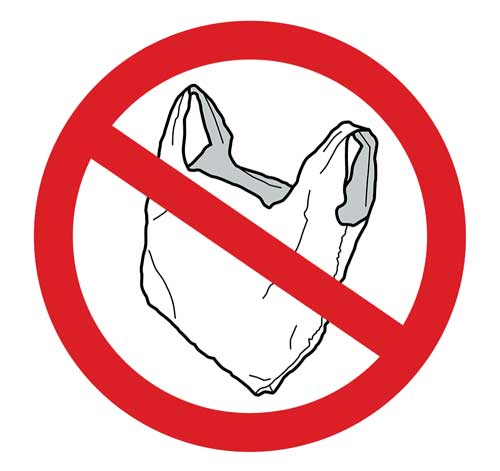
Snuffing the life out of the polythene devil
Following long periods of discussions, where there were disparities, the Government of Sri Lanka (GOSL) has shown some consistency in the build up to the ban on using disposable polythene.(The law will be effective from September). This decision will help minimize environmental issues caused by polythene usage.

It’s also fitting to note that the Central Environment Authority (CEA) has used all its tricks to promulgate the ban on polythene and the country’s law governing its usage.
Sri Lankan President Maithripala Sirisena, in his capacity as the Minister of Mahaweli Development and Environment, has proposed the implementing of a set of short, mediumand long term measures to minimize the use of polythene in Sri Lanka.
The measures recommended by the committee of intellectuals appointed to study the polythene issue received the approval of the Cabinet.
Short term measures proposed by President Sirisena to address the polythene issue:
- Prohibition of polythene use for decorations at all events.
- Implementation the prevailing regulations for the prohibition of, use, sale and production of polythene equals or less than 20 microns.
- Allowing the use of polythene less than 20 microns for essential activities only on the approval of Central Environmental Authority
- Prohibition of sale, importation and production of lunch sheets.
- Banning of sale, importation and production of containers, plates, cups and spoons.
- Prohibition of the sale of processed or cooked meals packed in polythene containers.
- Promotion of providing paper, cloth or reed bags or biologically degradable and environmental friendly plastics for customers when purchasing items.
- Prohibition of burning polythene and plastic in open places.
- Introduction and promotion of biologically degradable polythene and plastics.
- Imposing of 15% CESS during the importation of plastic raw material and related products and providing 5% out of that to the CEA to manage polythene and plastic waste.
Glass bottles must be made a renewable item
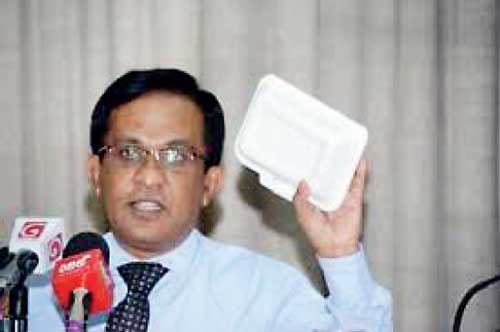
Hemantha Withanage
Centre for Environmental Justice Executive Director Hemantha Withanage revealed to the Dailymirror.lk that he was one of the committee members of the Eminent Panel appointed to study polythene use. “I was in fact affirmative on this regard and in a position to ban even plastic bottles which haven’t come under the new regulatory process. But I am glad that the law has been enforced after quite a few attempts in the past,” he said. Withanage proposed that glass bottles could be made renewable as the best alternative for the use of plastic bottles. He recommended the use of oil papers, wax paper bags and items made of sugarcane as the substitutes for polythene and plastic products.
“I should mention that many people who are in support of banning polythene and are waiting to adapt 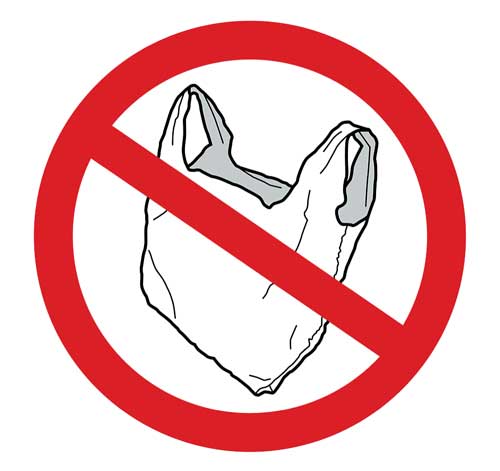
themselves with the use of items made of materials harmless to nature. When this issue came under the spotlight in 1995, it was extremely difficult for the people to get used to it. But after more than 20 years, if anybody says that it’s still inconvenient to get used to it, that is actually ridiculous. If countries like Rwanda, Morocco, Kenya and most of the European countries can totally ban the use of polythene, why are we incapable of doing it? Let’s do it for the sake of all Sri Lankans,” he pointed out. He said that the use of polythene should have been nipped in the bud. Therefore, the people of Sri Lanka should make use of this opportunity to do away with the use of polythene and get used to other alternatives. He underscored that Sri Lanka is ranked 5th in the world with regard to disposing garbage in the sea. He also requested the general public to join hands to support this new program and strive to totally eliminate polythene use from Sri Lanka.
Tax and VAT concessions for biodegradable material and machinery
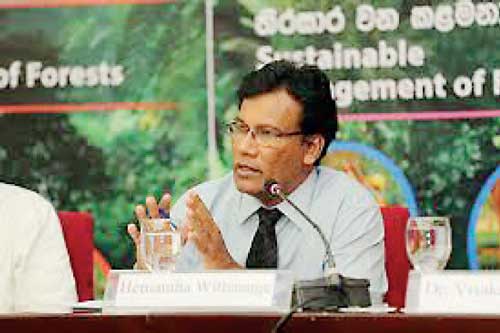
Ajith Weerasundara
Nevertheless, CEA Waste Management Director Ajith Weerasundara said that they would grant concessions regarding Taxes and VAT during the importation of biodegradable raw material and manufacturing machinery.
“We are in a firm position as to put this law into effect irrespective of any circumstances. Central Environment Authority (CEA) as a responsible branch aspires to conserve the environment. For that, we need the assistance and co-operation of the general public,” Weerasundara said. He mentioned that 10%-15% of polythene is inclusive in the total garbage collected daily and that one individual consumes 5kg of polythene per year which could exceed up to 7.2kg in the Western Province.
“We have discussed with the polythene manufacturing companies as to how they should face the music. We have recommended some of the products which are biodegradable. Some companies have supported our suggestions, but a few haven’t,” Weerasundara said.
Substitutes should be environmental friendly
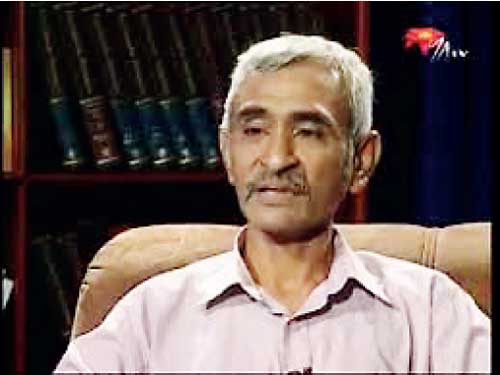
Jagath Gunawardena
Senior Environment Lawyer Jagath Gunawardena when contacted, categorically stated that the problem wasn’t regarding the use of polythene, but the manner in which it was disposed of .
The lack of manageable procedures for the disposal of polythene has been the core issue during the past
“The lack of manageable procedures for the disposal of polythene has been the core issue during the past. I don’t say that the banning of polythene isn’t relevant. It’s absolutely essential and pertinent. The government should see that viable alternatives will be accommodated,” he opined. Gunawardena further emphasized that substitutes should be environmental friendly and come under the provision of Consumer Affairs Authority.
Govt. should carry out subsidiary measures
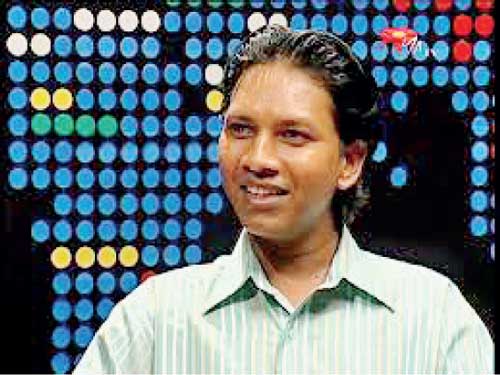
Sajeewa Chamikara
Environmentalist and Environmental Conservation Trust Director Sajeewa Chamikara told Dailymirror.lk that even though it was a bit late to implement the laws for the ban of polythene, the Government’s move was greatly commendable and applicable.
“I must say that the polythene issue has become a severe threat to Sri Lanka. Although, several implementations had been put into action, they weren’t as effective as they should have been.
Therefore, we should be thankful to this Government and the Central Environment Authority for their endeavours to implement the laws and the regulations to ban the use of polythene with effect from September 1,” Chamikara said.
He stressed that if we were to make this a reality, an apposite mechanism in the form of alternatives should be regulated to replace polythene. He pointed out that the government had regulated tax concessions for the importation and manufacturing of biodegradable raw material.
“The government should carry out subsidiary measures for the polythene manufacturers and the public before the law comes into effect to adapt themselves to the new alternatives.
When introducing alternative modes, the Government should ensure that their prices are affordable. The Government should take the pertinent steps to motivate the manufacturers of polythene. Otherwise, this will also be ineffective as it was evident for couple of times in the past,” he affirmed.
Chamikara further said that standards should be maintained and there should be legitimacy in enforcing the laws with respect to the ban on polythene, so as to not make it a
mere prohibition.
Unseen obstacles
In a brief interview with Dailymirror.lk , Sri Lanka Plastic Industry Association Chairman Sarath Wijesinghe, unearthed that the plastic industry in Sri Lanka would soon be in a tight spot due to the ban on polythene.
“The Government hasn’t provided enough time for the manufacturers to adjust themselves to alternative conditions. When there are more than thousand registered plastic factories at which there are more than 12,000 employees, the government hasn’t monitored its structures before banning polythene. It’s not fair,” Wijesinghe said.
He further said that more than 2 million lunch sheets are used daily in relative areas in Colombo. He went on to state that once the ban on polythene is effective, people will have to use items like boxes.
In order to wash them with water, it would require 5 litres of water per day.
He asked whether the Government could provide 5 litres of water per day only to Colombo? Therefore, they urged the Government to view this issue in a different perspective and take efficient action to see that the provisions proposed are fair.
Source – 11/08/2017, Daily mirror, See more at – http://www.dailymirror.lk/article/Snuffing-the-life-out-of-the-polythene-devil-134500.html
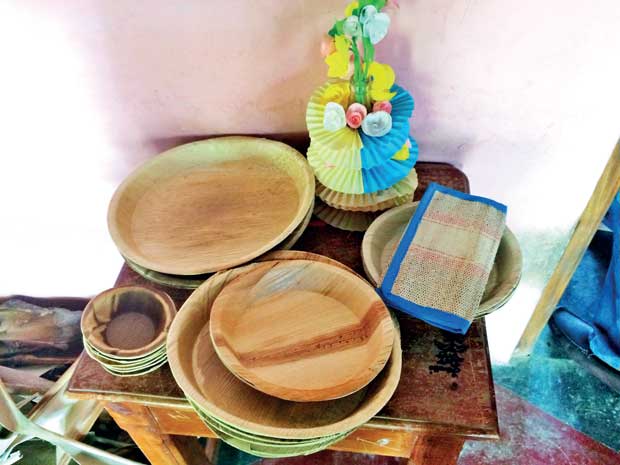
Saving us from plastic, one plate at a time
Disposable cutlery and containers are products that are a part of our day to day life. As a result of the ever-increasing number of food vendors in Colombo and the suburbs, plastic cups, plates and cutlery that are hardly used are seen tossed into bins regularly.

Dinnerware made from areca sheath
However there is a ban in place connected to disposable items. This means that the ordinary vendor and consumer must both take responsibility, a task that some are less inclined to embrace. A small group of entrepreneurs up North however are already taking action and demonstrating how to take responsibility by providing green solutions to the community. While many lament the inconvenience, this group isn’t only making good use of organic material, but also helping the environment, one plate at a time.
In Thirumurikandy, off the A9 highway, several kilometres before the Iranamadu junction,in Kilinochchi, an elderly gentleman opens the gates of a small enclosure to greet us. A small house sits in the middle of an expansive land with blossoming rows of tender coconut trees planted in between.  Areca sheaths hang from ropes tied between trees, drying out in the sun. As we enter the house several young women appear with welcoming smiles. No sooner than we can say hello, the young ladies spring into action, showing us what they are capable of with their new and exciting venture.
Areca sheaths hang from ropes tied between trees, drying out in the sun. As we enter the house several young women appear with welcoming smiles. No sooner than we can say hello, the young ladies spring into action, showing us what they are capable of with their new and exciting venture.
“The initiative was launched by our company this year in an effort to promote and embrace a greener lifestyle,” Gowri Ananthan of Kudhil products, facilitating this cottage industry said. “Our operational, research and development and training unit is situated in Ariviyal Nagar, Killinochi which is mainly focusing on providing job opportunities to war affected communities,” she said. The entrepreneurs hope to export the final products to US and Canada as well.

Manufacturing plates with areca sheath
“Apart from this, our company is engaged in importing and supplying machinery to extract banana fibre and to make plates and cups out of areca sheath. We also import and install coir pot making machinery, natural fibre weaving machinery and paper bag making machinery,” Gowri elaborated.
Brand new machines imported from India are installed in the verandah. Small piles of banana tree trunks and areca sheaths sit in the garden closer to the house. It takes a village to make organic disposable plates, we learn. Villagers collect locally grown areca sheaths and the native palmyrah sheaths which they use in the production of disposable dinnerware. Traditionally, areca leaves have been used to pack cooked rice and to preserve treacle made of “Fish Tail Palm”. Matured stems are used as a building material as well as for decoration of religious events. But in Kilinochchi, the ladies are quite busy collecting sheaths for a better cause. In addition to this, they also use the banana stem, purchased from villagers.
Once plantains are harvested the banana tree is disposed of, as it bears fruit only once. The stem of the banana plant has long been considered to be high in nutrition value, even though it is disposed of in most banana plantations. As a solution to the increasing issue of processing stem waste, entrepreneurs in South India began manufacturing bio-degradable dinnerware from organic waste such as the banana stem. Extracting good quality fibre from these stems is now a popular business enterprise especially with an increased need for reusable and environment friendly alternatives in Asia.

Purses made from banana fibre
Our operational, research and development and training unit is situated in Ariviyal Nagar, Killinochi which is mainly focusing on providing job opportunities to war affected communities
The manufacturing of plates involves a process of die cutting. A die is a specialized tool used in manufacturing industries to cut or shape material mostly using a press. Like moulds, dies are generally customized to the item they are used to create. The cutting process using a die is however a simple one. The upper die presses into the lower die assembly, with the dried sheath or leaf placed in between. The machine is operated by pressing a foot pedal. The heat regulator is set to maintain the main die temperature at about 150 Degrees Celsius. The die is heated by domestic energy which makes it ideal for a manufacturing set up in rural areas.
After a few seconds, the foot on the pedal is withdrawn and a cured leaf plate is produced. Finishing of the product is done by just trimming the edges of the manufactured plate. One of the most noteworthy attributes of this process we noted is that the manufacturing required no adhesive or chemical, making it completely safe for consumers. It’s a reliable, biodegradable and compostable alternative to petrochemical based plastic and polystyrene plates.

The plate machine
Still in its experimental and training phase, the employees are enthusiastically testing the possibility of making plates from lotus leaf as well. The revolutionary product is strong like its plastic rival and doen’t leak. But as we observed, the art of perfecting the skills of plate making is no easy task and requires efficiency of movement.
Still in its experimental and training phase, the employees are enthusiastically testing the possibility of making plates from lotus leaf as well
As the sheath is placed on the machine, it cuts and presses a portion of the leaf into a plate. The challenge for the operator is to try and save as much sheath left over as possible for the next plate. They also require the skill to know the precise moment when to lift the heated mold; when the plate is cured, but not burnt.
Meanwhile at another corner of the house, sat a young lady at a machine extracting fibre from banana sheaths. The extracted fibre after being dried are then woven into fabrics of beautiful shades. Another sat at a sewing machine, stitching together various pieces of woven mat and fabric. The final products they showed us included bags, purses and even pouches for phones. Successive Sri Lankan governments have always favoured bans, regardless of how prepared the country is to effectively implement it. The polythene and plastic ban which comes into effect from September 1, prevents the use of polythene lunch sheets, rigifoam boxes and shopping bags. While many are praising the move, another group are lamenting the inconvenience it will cause. The women and men of Kilinochchi taking up the challenge of providing a greener alternative, are indeed exemplary.
Source – 11/08/2017, DailyMirror, See more at -http://www.dailymirror.lk/article/Saving-us-from-plastic-one-plate-at-a-time-134501.html
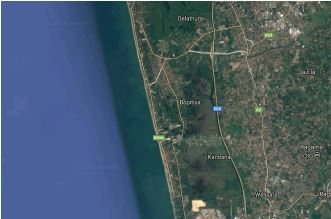
Sri Lanka to kick off solid waste plants with USD193 mln investment
Aug 10, 2017 (LBO) – Sri Lanka will see two solid waste-to-energy power plants starting construction as two public-private partnership (PPP) projects in Muthurajawela.
The total invest for the project will be around 193 million dollars, the Ministry of Megapolis and Western Province Development said.
The two plants will add 20 Mega Watts of electricity to the national grid once commissioned and will convert waste generated in Colombo and Gampaha into energy.
The first project will see 700 Metric Tons of waste generated from the Colombo Municipal Council daily being processed through an incineration plant run by the Western Power Company, a fully-owned subsidiary of Aitken Spence Plc.
The investment for the project will be 98 million dollars and will add 10 MW to the national grid.
The second, also a PPP with a Korean company called K.C.H.T Jang, will invest US 95 million dollars to set up a plant to process up to 630 MT of unsorted waste generated from the suburbs of the Colombo and Gampaha districts.
This plant will add another 10 MW to the grid.
A third project, with an investment of US 91 million dollars is also due to commence later this month. All three plants are to be completed within a two-year period, the ministry said.
Another PPP agreement has been signed with Fairway Holdings for a waste treatment plant in Karadiyana, where 500 MT of waste will be processed into energy.
According to available data the Western Province alone produces around 60 percent of the nation’s waste, with 3,400 metric tons produced per day.
About 86 percent of waste is dumped in the open with only about 6 percent of this made into compost and about 4 percent of it recycled.
source – 10.08/2017, Lanka-business online, See more at – http://www.lankabusinessonline.com/sri-lanka-to-kick-off-solid-waste-plants-with-usd193-mln-investment/

